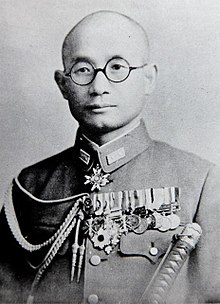Masanobu Tsuji | |
|---|---|
 | |
| Nickname(s) | God of Strategy |
| Allegiance | |
| Service | |
| Years of service | 1924–1945 |
| Rank | |
| Battles / wars | |
| Alma mater | Army War College |
| Born | 11 October 1902 Ishikawa Prefecture, Japan |
| Disappeared | April 1961 Laos |
| Status | Declared dead 20 July 1968 |
| Part of a series on |
| Statism in Shōwa Japan |
|---|
 |
Masanobu Tsuji (辻 政信, Tsuji Masanobu, 11 October 1902 – went missing in 1961[1]) was a Japanese army officer and politician. During World War II, he was an important tactical planner in the Imperial Japanese Army and developed the detailed plans for the successful Japanese invasion of Malaya at the start of the war.[2][3] He also helped plan and lead the final Japanese offensive during the Guadalcanal Campaign.
A Pan-Asianist, Tsuji pressured Asian countries to support Japan in World War II, despite being involved in atrocities such as the Bataan Death March and Sook Ching. He meticulously planned the mass murders in Singapore and surrounding regions.[4] He personally oversaw the Pantingan River massacre.[5] He evaded prosecution for Japanese war crimes at the end of the war and hid in Thailand. He returned to Japan in 1949 and was elected to the Diet as an advocate of renewed militarism. Through the 50's he worked for American intelligence alongside Takushiro Hattori. In 1961, he disappeared on a trip to Laos.[6]
Tsuji was among the most aggressive and influential Japanese militarists. He was a leading proponent of the concept of gekokujō, (literally "the bottom overthrowing the top") by acting without or contrary to authorization.[6] He incited the 1939 border clash with the Soviet Union and was a vehement advocate of war against the United States.[7]
- ^ Tsuji's birthyear is disputed. Several Japanese sources use 1903, but Tsuji himself wrote that it was 1901. Other sources state 1900 or 1902. The 1901 date is from David Bergamini's Japan's Imperial Conspiracy, p. 981.
- ^ Toland, John (2003). The Rising Sun: The Decline and Fall of the Japanese Empire, 1936–1945. New York: Modern Library. p. 183. ISBN 978-0-8129-6858-3. OCLC 52441692.
- ^ Rigg, Bryan Mark (2024). Japan's Holocaust: History of Imperial Japan's Mass Murder and Rape During World War II. Knox Press. p. 94. ISBN 9781637586884.
- ^ Rigg, Bryan Mark (2024). Japan's Holocaust: History of Imperial Japan's Mass Murder and Rape During World War II. Knox Press. p. 99. ISBN 9781637586884.
- ^ Rigg, Bryan Mark (2024). Japan's Holocaust: History of Imperial Japan's Mass Murder and Rape During World War II. Knox Press. p. 104. ISBN 9781637586884.
- ^ a b Budge, Kent G. "Tsuji Masanobu (1901–1961?)". The Pacific War Online Encyclopedia. Retrieved 28 April 2012.
- ^ Goldman, Stuart (28 August 2012). "The Forgotten Soviet–Japanese War of 1939". The Diplomat. Retrieved 28 March 2023.